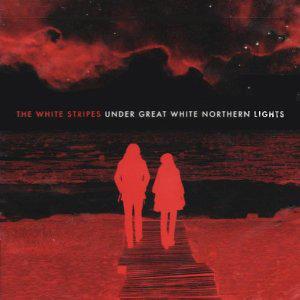In the first scene of director Emmett Malloy’s White Stripes documentary, “Under Great White Northern Lights,” a confused fan stumbles up to the camera and asks, “Where’s the show, guys?” For a film about one of the most perplexingly idiosyncratic, mannered, and sincere bands going, this question perfectly summarizes the sentiments of the audience as they sit through 93 minutes of tour footage where the band members never quite reveal the pretense—or if there even is a pretense—behind their show of weirdness. Unfortunately, despite its musical strength, “Under Great White Northern Lights” provides little response to the fan’s question, opting instead for an unfocused, superficial look at the White Stripes.
No one but Jack White—who spends most of the film smiling like a satanic Cheshire cat—could dress mostly in red jump suits and walk around surrounded by bowler-hat-wearing, bag-pipe-playing roadies without seeming obviously fake. The Stripes’ utter commitment to their art is evident throughout the musical component of the documentary, where the White Stripes put on a series of impassioned concerts in diverse and bizarre venues. Jack and Meg begin each show, after brief bag pipe introductions, by marching straight onto stage (or lane, in the case of a concert at a bowling alley), picking up their instruments and playing without preplanned tempos or set lists. In one scene, the band takes the stage only to play one note before walking off. In another, they trade songs with Inuit elders, who nod off in time to the blues stylings of Jack. Throughout the film, the Stripes blaze through their 10-year catalogue, now rife with hits, accelerating and decelerating throughout every song and playing with an unhinged passion worthy of any classic rock or punk greats. The audio, also available in CD release, does an excellent, earsplitting job of capturing the fractured intensity of a White Stripes live show.
The film, however, does little more than present clips of these shows in relatively unexciting footage. Much of the film is shot in black and white, a treatment completely contrary to the White Stripes’ fervent belief that their music is spontaneous and immediate—not emulative and rooted in the past. Additionally, the black and white filter seems like a post-production effect added to produce some sense of feigned authenticity. This, too, is completely contrary to the White Stripes’ own recording methods, which involve tape-recording with little to no post-production work. There exists a much-admired White Stripes aesthetic and style, and this film doesn’t capture it.
The best portions of the film are the impromptu gigs the Stripes play in out-of-the-way venues like buses, bowling alleys and elderly homes. Nothing suits the White Stripes’ spontaneity better than a surprise show, and these concerts are the most unique part of the tour. However, they receive less screen time than the stage shows, which, while aurally impressive, are not nearly as engaging in terms of narrative and filmmaking as their off-stage counterparts.
This lack of narrative focus is reflected in the film’s lack of an overarching conceptual theme. While Malloy flirts with several, his inability to construct one comprehensive thesis leaves the film unfulfilling and incoherent. Early on, it’s a straight-ahead concert film. Then, it’s a tribute to the band’s oddball stage mannerisms. Then, it begins to explore the intricate and fascinating relationship between Meg and Jack. One revelatory glimpse of the two, in which a sheepish Jack consoles Meg after driving her to tears with a piano ballad, suggests that this relationship is worthy of an entire film’s worth of material. This thread is abandoned, however, for nostalgic coverage of the White Stripes 10th anniversary concert, complete with a cheesy black-and-white freeze-frame of Jack and Meg waltzing at the end of the show. Any of these threads, if fully pursued, could have made an interesting movie, but Malloy’s attempt to encompass all of them results in a fractured and meaningless film, no more enjoyable than a series of White Stripes YouTube clips watched consecutively.
While the film serves as a reminder of how eccentrially vital the White Stripes are, it adds nothing new or unheard to their mythology. In one scene, Jack White addresses the accusation that everything about the band is contrived, saying, “People say it’s all premeditated, but it was premeditated 10 years ago.” In the intervening 10 years, nothing about the White Stripes’ premeditated style has changed. The film fails to prove its significance, coming off as more of a limp reminder than a revelatory take on the utterly fascinating world of the White Stripes.
—Staff writer Benjamin Naddaff-Hafrey can be reached at bhafrey@college.harvard.edu.
Read more in Arts
POPSCREEN: Lady Gaga ft. Beyoncé













